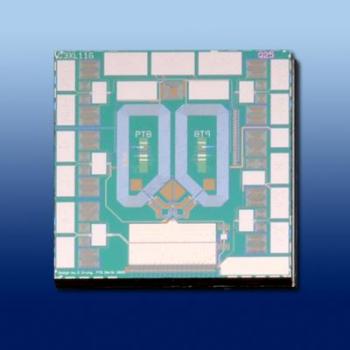May 23 2013
With their SQUIDs, low-temperature specialists of the Physikalisch-Technische Bundesanstalt (PTB) have made it possible for the magnetic moments of atoms of the rare isotope 3He (helium-3) to be measured with extreme sensitivity.
 PTB SQUID sensor chip (3 mm x 3 mm) is manufactured similarly to a computer chip in the semiconductor industry. Credit: PTB
PTB SQUID sensor chip (3 mm x 3 mm) is manufactured similarly to a computer chip in the semiconductor industry. Credit: PTB
With the aid of these sensors, highly sensitive nuclear resonance spectrometers were developed which have now provided deep insights into the state of matter at extremely low temperatures. In concrete terms, the international research group from London, Ithaca (USA), and PTB's Berlin Institute confined the helium-3 as extremely thin – quasi two-dimensional – liquid film. With their extremely precise measuring instruments, they were then able to measure the properties of the superfluid more exactly than ever before. In this way, they have made an important step towards understanding the unique quantum liquid helium-3 and its superfluid properties. The results have been published in the current edition of the magazine "Science".
PTB's SQUIDs are outstanding worldwide. The superconducting quantum interference devices are the most precise measuring instruments available to detect extremely weak magnetic signals. They are already used routinely, e.g. in biomedical measurements, to examine the magnetic fields of the human brain or heart. What is even more topical is their use together with other superconducting detectors to measure radiation with extreme sensitivity or to detect even single photons (see also Nature 497, 227–230, 9 May 2013). And the third application is that of the current study: Since the mid-90s, PTB's SQUIDs have played a central role in the cooperation between scientists of the Royal Holloway University of London and PTB's cryogenic sensor group. This has led to particularly sensitive nuclear resonance spectrometers for experiments at ultra-low temperatures in order to gain ever deeper insights into the state of matter at these extreme conditions. Among other things, the scientists aim at investigating helium-3 – a unique quantum liquid.
Helium-3 is the much rarer sister of helium-4 which you need, e.g., to bring the coils of a magnetic resonance tomograph to working temperature. For this purpose, they must become superconducting, which is only possible with the temperature of the liquid helium-4 being -269 °C (4 K), i.e. approximately 4 °C above absolute zero. If you want to get even closer towards absolute zero, you will need helium-3. Its natural abundance is 10,000 times lower than helium-4 and, therefore, helium-3 is synthesized in nuclear reactors. Only by means of a mixture of the two helium isotopes and a sophisticated magnetic cooling technique can matter be cooled down to a few millionths of a kelvin above absolute zero and experiments can then be carried out with these materials.
It is evident that the scientists have a great interest in getting to know their unique cooling liquid as well as possible. Helium-4 and helium-3 are fascinating substances as they become superfluid at very low temperatures and can thus flow without frictional resistance. However, the superfluids of the two isotopes vary significantly from a quantum-mechanical point of view, as helium-4 atoms are bosons, whereas helium-3 atoms are fermions. In the latter, superfluidity develops through the formation of pairs of helium-3 atoms via magnetic interaction. These magnetic properties thus decisively determine the properties of the superfluid.
Physicists of the low-temperature laboratory of the Royal Holloway University of London in cooperation with Cornell University of Ithaca, USA are dealing with the detailed investigation of these superfluids under extreme conditions. It gets really exciting for the physicists if you confine the liquid under pressure at extremely low temperatures below one thousandth of a degree above absolute zero in thin cavities which are only several hundred nanometres thick (i.e. 50 to 100 times thinner than a human hair). Then the behaviour of the helium-3 atoms, or of the pairs which make up the superfluid, will be strongly influenced by this movement restriction in one dimension. Especially the surface scattering of the particles in the cavity has a great influence on their properties, similar to a football which – shot at a smooth or rough wall – will bounce off more or less predictably. The conditions in this ultracold liquid lamella – the physicists hope – will enable the detection and investigation of excitations that behave like so-called Majorana fermions (particles being their own antiparticle).
The challenging problem for these kinds of experiments is the measurement of the properties of the extremely thin helium-3 liquid lamella. As the interactions of the magnetic moments of the helium-3 atomic nuclei play a decisive role, so-called nuclear magnetic resonance spectroscopy – a measurement technique similar to magnetic resonance imaging (MRI) for medical diagnostics – is applied. Magnetic resonance spectra are characteristic fingerprints of the state of the helium-3 atoms from which information about the properties of the liquid can be obtained. It is just that magnetic resonance spectroscopy of helium-3 deals with much weaker signals and extreme temperature ranges than medical MRI. Extremely sensitive magnetic field sensors which operate reliably at ultra-low temperatures are needed. Here, the SQUIDs, which have been developed by PTB's physicists and engineers for more than two decades, came into play. PTB's SQUID sensor technology was implemented at the Royal Holloway University of London into the experimental set-up which was finally used to measure the properties of helium-3 liquid lamellas. The results achieved are an important step to understanding this unique quantum liquid. The groups of scientists are already working on improved sensor arrangements which, in future, will be used to examine helium-3 liquid lamellas with spatial resolution. The work was one of a number of research activities funded by the EU within the framework of the "European Microkelvin Collaboration".